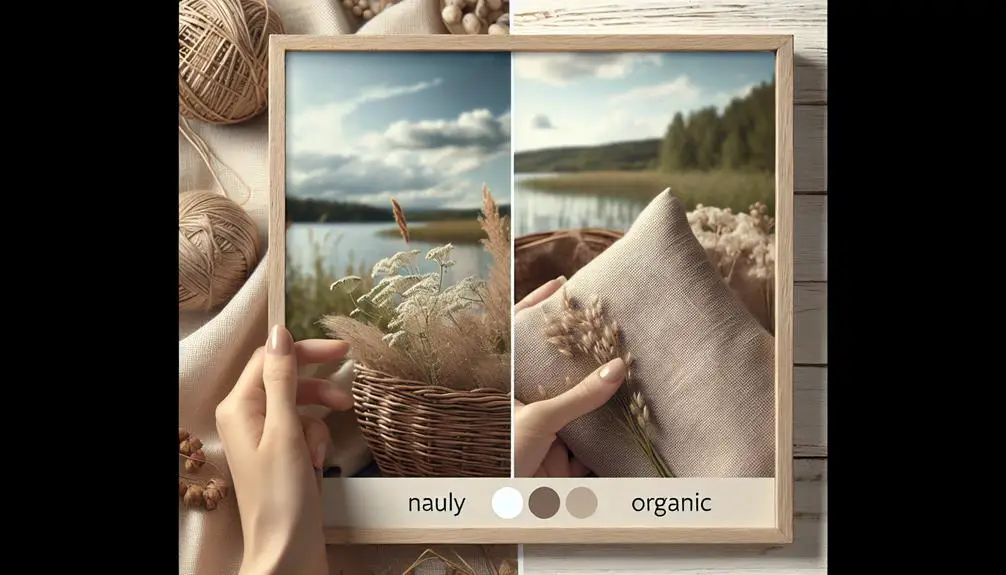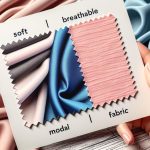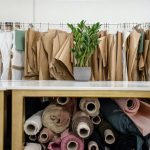I've always been a fan of linen for its breezy, comfortable feel, especially during the warmer months. But, I recently stumbled upon modal, and I gotta say, it's a game-changer. It's not only soft like silk but also does wonders in terms of absorbency and breathability, which is a big plus for anyone who's been in a love-hate relationship with linen's wrinkle-prone nature. Plus, the fact that it's eco-friendly makes it even more appealing. Now, if you're curious about how modal stacks up against other linen alternatives, well, there's a whole world of fabrics out there waiting to be explored.
Table of Contents
Key Takeaways
- Ramie offers a distinct texture and minimal chemical processing, making it a strong contender for structured pieces similar to linen.
- Hemp is impressively durable and requires minimal water for cultivation, providing a sustainable alternative with a feel akin to linen.
- Tencel, known for its softness and eco-friendly properties, offers a luxurious drape and comfort comparable to linen.
- Modal features a silk-like texture and high absorbency, bridging the gap between linen's traditional feel and modern benefits.
- Polyester blends mimic linen's aesthetic with versatile textures and finishes, providing a cost-effective alternative for linen-like clothing.
Cotton: A Linen Alternative
When looking for a cozy alternative to linen, cotton's got you covered with its softness and ease of care. Honestly, diving into the world of cotton after dealing with linen's high-maintenance vibes was a game-changer for me. This fabric doesn't just come in one generic type; we're talking Organic, Upland, Egyptian, and Pima. Each has its unique charm, offering a range of textures and qualities that can suit pretty much any preference.
I've always leaned towards materials that don't demand a ton from me in terms of care, and cotton hits that sweet spot. It's durable yet soft, making it perfect for everything from your favorite tee to those bed sheets you can't wait to dive into at the end of the day. Plus, cotton's moisture absorption is top-notch, keeping you comfy and dry.
The versatility of cotton, with its vibrant prints and easy-to-care-for nature, competes head-on with linen. While linen has its perks, cotton's softness and the fact that it's easier to mass produce make it a frontrunner for me. It's the go-to fabric for those of us wanting that linen-esque feel without the fuss.
Ramie: Durable and Lightweight
So, let's talk about ramie, a fabric that's not only tough and light but also kind to our planet.
Comparing it to linen, ramie stands out for its durability and unique texture, making it a fantastic choice for anyone looking for an alternative.
I'm curious to explore how it measures up in terms of environmental impact and why it might just be the next big thing in sustainable fashion.
Ramie's Environmental Impact
I've found that ramie's minimal need for pesticides and fertilizers during its growth makes it a top environmentally friendly fabric choice. This natural fiber, derived from nettle plants, not only boasts durability and a lightweight feel but also champions sustainability. Here's why:
- Low Chemical Processing: Ramie's production involves minimal chemical usage, significantly reducing its environmental footprint.
- Highly Absorbent and Breathable: Its natural properties make it ideal for various uses without the need for synthetic enhancements.
- Resistant to Bacteria Growth: This feature cuts down on the need for chemical treatments to maintain the fabric, further cementing its eco-friendly status.
Comparing Ramie and Linen
Let's dive into how ramie and linen stack up against each other, starting with their shared durability and lightweight nature. Both ramie fabric and linen hail from the world of natural, plant-based textiles, boasting impressive strength and a breezy feel that's hard to match.
Ramie, derived from nettle plants, mirrors linen's absorbency, breathability, and robustness. Yet, it steps up with a distinct texture, giving it an edge for structured pieces like trousers and blazers. This fabric offers garments a boxy silhouette while maintaining that sought-after lightweight comfort.
For those of us leaning towards sustainable fashion choices, ramie emerges as a stellar eco-friendly counterpart to linen, blending durability with environmental consciousness. It's a win-win for anyone wanting to keep their wardrobe both resilient and in tune with nature.
Hemp: Eco-Friendly and Robust
So, let's talk about hemp, another fabric that's giving linen a run for its money.
It's not just about being eco-friendly; its durability and versatility are through the roof.
Whether it's crafting durable clothing or exploring its varied uses, hemp's definitely a heavyweight contender in the sustainable fabric arena.
Sustainable Cultivation Practices
When it comes to sustainable fabrics, hemp stands out for its eco-friendly cultivation practices. Unlike the flax plant, which is also used for making linen, hemp sets a high bar for environmental stewardship in the textile industry. Here's why:
- Minimal Water Use: Hemp requires significantly less water than many other crops, including the flax plant. This makes it a champion of water conservation.
- No Need for Pesticides: Hemp grows like a weed, meaning it doesn't need chemical help to thrive. This keeps our waterways clean.
- Improves Soil Health: Through phytoremediation, hemp actually leaves the soil healthier than before it was planted. It's like giving back to the Earth.
These points outline why hemp isn't just a fabric choice but a step towards a more sustainable future.
Durable Fabric Qualities
After exploring hemp's sustainable cultivation, it's worth noting that it's not just eco-friendly but also impressively durable as a fabric. Unlike cotton and linen, which are already known for their robustness, hemp takes it up a notch. It's got this incredible resilience that stands up to wear and tear like a champ.
Because it's derived from a plant that's tough enough to grow without much water or any pesticides, you can bet the fabric itself is pretty hardcore. It's not just about being tough, though. Hemp is also breathable, moisture-wicking, and even gets softer every time you wash it.
Versatile Use Cases
Hemp's versatility shines through in its wide range of uses, from comfy tees to durable backpacks and cozy home textiles. This eco-friendly fabric has got it all: sustainability, durability, and a knack for getting comfier over time. Here's why I'm all in on hemp:
- Eco-Friendly Choice: Hemp grows fast, uses less water, and doesn't need pesticides, making it a superstar for the environment.
- Tough as Nails: This fabric can handle whatever I throw at it, from rigorous hikes to daily wear, without giving up the ghost.
- Comfort King: With moisture-wicking and anti-bacterial properties, it's my go-to for staying fresh and dry, whether I'm lounging at home or out on an adventure.
Hemp's not just another fabric; it's a lifestyle choice that keeps on giving.
Bamboo: Soft and Sustainable
Bamboo's softness and sustainability make it an awesome alternative to linen for those of us looking to go green. I've been diving into eco-friendly fabrics lately, and bamboo really stands out. It's not just about being soft to the touch; the whole process of growing bamboo is a win for the planet. These plants shoot up quickly, needing hardly any water or pesticides. That's a big deal if you're like me, trying to make choices that are kinder to the Earth.
What's really cool about bamboo fabric is its natural antibacterial properties. If you've got sensitive skin or you're just tired of clothes that start smelling before the day's over, bamboo's your friend. Plus, it's breathable and moisture-wicking, which means staying comfortable and dry isn't a problem. And let's not forget the UV protection it offers, just like linen.
But here's the kicker – bamboo fabric feels silky, drapes beautifully, and, yes, it's biodegradable. Choosing bamboo means I'm not just picking a fabric that feels good and looks good; I'm also making a choice that respects the planet. It's a no-brainer for anyone aiming for a more sustainable lifestyle.
Tencel: Smooth and Moisture-Wicking
Shifting gears to another eco-friendly superstar, let's talk about Tencel, a fabric that's not only smooth to the touch but also masters moisture-wicking like a pro. Coming from wood pulp, this sustainable champ brings a lot to the table, especially for those of us keen on keeping our environmental footprint in check while still looking sharp.
Here's what sets Tencel apart:
- Softness and Silky Feel: It's softer than linen and has this luxurious silky feel that drapes beautifully. Whether it's for shirts, dresses, or trousers, Tencel adds that extra bit of elegance and comfort.
- Eco-Friendly and Breathable: Not only is it lightweight and breathable, making it a perfect choice for almost any season, but it's also environmentally friendly. Being biodegradable and made from renewable resources, Tencel aligns perfectly with eco-conscious values.
- Durability and Versatility: This fabric doesn't just look and feel good; it's also resistant to wrinkles and maintains color vibrancy well. Plus, its versatility across various clothing items means you can enjoy its benefits in many forms.
In a world where eco-friendly choices are becoming increasingly important, Tencel offers a fantastic alternative that doesn't skimp on luxury or performance.
Viscose: Breathable and Silky
Diving into viscose, we find a fabric that's both breathable and silky, blending the best of both worlds for our wardrobe. This unique mix of 75% viscose and 25% linen gives us something truly special. With its textured slub finish, it's not just another fabric; it's a statement of style and comfort. The drape is incredible, making it a dream for designers and DIY enthusiasts alike.
What I love about viscose linen is its versatility. Whether I'm sewing a breezy shirt, a flowing dress, or a pair of comfy trousers, this fabric gets the job done beautifully. It's lightweight and breathes like a dream, which is a godsend on those warm summer days. Plus, the smooth and silky feel? It elevates every piece I create, adding a touch of luxury.
The opacity of viscose linen adds another layer of appeal. It's perfect for creating garments that need a bit of coverage without sacrificing style. And let's talk about the elegance it brings to flowy pieces. The excellent drape and breathability make it my go-to for creating looks that are both elegant and comfortable. Honestly, viscose linen is a game-changer for anyone looking to blend sophistication with wearability.
Modal: Stretchy and Soft
I've discovered that modal fabric, with its incredible softness and stretch, is a real wardrobe game-changer. While exploring materials similar to linen, modal stood out for several reasons. It's not just about the feel; there are practical benefits that make it a stellar choice for anyone looking to elevate their fabric game.
Here's why modal is a must-try:
- Softness and Comfort: Similar to linen in its natural vibe but leagues ahead in terms of softness, modal offers a silk-like texture that's unbeatable against the skin. It's perfect for those pieces you'll wear day in, day out.
- Moisture-Wicking Abilities: Like linen, modal is highly absorbent, making it an excellent choice for activewear or daily essentials, especially in warmer climates. It keeps you cool and dry, which is always a win in my book.
- Durability and Maintenance: This fabric doesn't just feel good; it's also resistant to shrinkage and fading. The fact that it maintains its shape and color after numerous washes means less hassle for me, and likely for you too.
Plus, its eco-friendly nature, thanks to the beech tree's minimal water needs, adds another layer of appeal. Modal, in my experience, bridges that gap between wanting something similar to linen but with added benefits.
Lyocell: Eco-Friendly Luxury
Exploring further into eco-friendly fabrics, I stumbled upon lyocell, a luxury material that's both sustainable and soft as linen. It's like discovering a hidden gem in the world of textiles. This fabric doesn't just talk the talk; it walks the walk with its eco-friendly production process and a luxurious feel that rivals linen.
| Feature | Lyocell | Linen |
|---|---|---|
| Texture | Smooth and Soft | Crisp but Softens with Use |
| Breathability | Highly Breathable | Highly Breathable |
| Moisture-Wicking | Excellent | Excellent |
| Wrinkle-Resistance | Resistant | Less Resistant |
| Environmental Impact | Low, Biodegradable | Low, but varies |
Lyocell's similarity to linen isn't just about the feel or the look; it's about embracing sustainability without sacrificing luxury. I've found it's perfect for those who love the classic appeal of linen and cotton but are eager to make eco-conscious choices. It's versatile enough for a range of clothing, from breezy shirts to elegant dresses, making it a staple for anyone aiming to refine their wardrobe with sustainable options. The fact that it's biodegradable just adds to its allure, proving that fashion and responsibility can indeed go hand in hand.
Polyester Blends: Versatile and Affordable
While not as eco-conscious as lyocell, polyester blends offer a durable and cost-effective alternative to linen. They've got this amazing versatility that makes them a go-to for anyone looking for that linen vibe but at a price point that's a bit more wallet-friendly. And let's be real, who doesn't love a good deal?
Here's why I'm all in on polyester blends:
- Durability and Ease of Care: These blends are tough. They can handle whatever your day throws at them without wrinkling up or wearing out. Plus, they're a breeze to take care of. A quick wash, a fast dry, and you're good to go.
- Aesthetic Flexibility: You can find polyester blends in a bunch of different textures and finishes. This means you can get that linen look for less than linen, whether you're dressing up or keeping it casual.
- Comfort and Practicality: Okay, so they're not as breathable as linen, but they still do a solid job of keeping you looking sharp. They mimic linen's aesthetic so well, you might forget you're wearing something different.
In essence, if you're after the linen look without the linen price tag, polyester blends are your best bet.
Frequently Asked Questions
What Material Is Closest to Linen?
I'd say ramie's the closest to linen, being strong, durable, and breathable. It's made from nettle plants, which gives it similar features. Plus, it has that natural vibe linen's famous for. Pretty cool, right?
What Fabrics Are Like Linen?
I've discovered that fabrics like ramie, cotton linen blends, Sorona linen, viscose linen blends, and linen-like materials with crease-resistant finishes are all great alternatives to linen, offering similar qualities like breathability and strength.
Is Polyester Similar to Linen?
No, polyester isn't similar to linen. It's synthetic, lacks linen's breathability, and doesn't offer the same natural, textured look. I prefer linen for its eco-friendly qualities and luxurious feel that polyester just can't match.
Is 100% Cotton the Same as Linen?
I've learned that 100% cotton isn't the same as linen. Though both are natural, cotton's softer and more flexible, while linen's sturdier with a unique texture. Each has its own uses due to these differences.
- Recycling Nonwoven Fabrics: Is It Possible? - July 11, 2025
- Recycling Nonwoven Fabrics: Is It Possible? - July 11, 2025
- Recycling Nonwoven Fabrics: Is It Possible? - July 11, 2025






